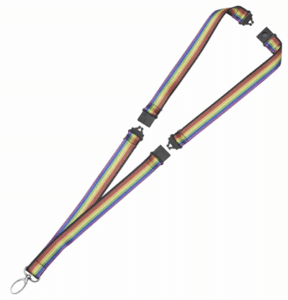
Rainbow lanyards have become a widespread accessory in many workplaces, schools, and public spaces across the UK. These vibrant items are more than just practical tools for holding ID badges or keys; they are powerful symbols of support for the LGBTQ+ community.
So, it was disappointing for many to see something so unassuming and with such a positive message get dragged through the mud by the former UK government.
Those recent discussions have cast a spotlight on the political and social implications of wearing rainbow lanyards, sparking a national conversation about their significance.
Which begs the question – are rainbow lanyards really that controversial? Should they be banned from official workplaces?
The Political Debate
In May 2024, the UK found itself in the midst of a heated debate over rainbow lanyards. The controversy began when several high-profile political figures questioned the use of rainbow lanyards in government offices and public institutions, suggesting that their presence might be seen as endorsing a particular political stance.
It was led by Esther McVey, the Conservative MP who was the ‘common sense’ minister, who argued that anyone working for the government should be banned from wearing rainbow lanyards because they should leave their personal views “at the building entrance”.
This sparked a broader conversation about the role of such symbols in professional environments and whether they contribute to inclusivity or create divisions. Is it really divisive to support the LGBTQ+ community in this day and age?
Those who stood up to McVey argued that rainbow lanyards are a simple yet powerful way to show solidarity with the LGBTQ+ community, promoting a message of acceptance and equality. It’s not exactly shouting from the rooftops, nor is it directly confronting those who don’t believe that the LGBTQ+ community needs or deserves support.
Critics, however, contend that mandatory or widespread use of these lanyards can be coercive, pressuring individuals to publicly display their support for causes they might not personally align with or feel comfortable discussing.
They believe that wearing a lanyard can suggest that the wider institution has a specific viewpoint, and that anyone who doesn’t share those views may not be seen as being welcomed.
Why People Choose Rainbow Lanyards
Despite the controversy, many people still continue to choose rainbow lanyards for a variety of reasons.
Expression of Support
For a lot of people, wearing a rainbow lanyard is a straightforward way to show their support for LGBTQ+ rights. It’s a visible commitment to fostering an inclusive environment where everyone feels valued and respected.
It doesn’t automatically mean that the wearer is a member of that community – many allies choose to wear them too, especially if they have family members or friends who they wish to support.
Visibility and Advocacy
Rainbow lanyards serve as a constant reminder of the ongoing struggle for equality and the importance of visibility for the LGBTQ+ community. They help to keep the conversation going and signal to others that they are willing to fight against discrimination.
Creating a Safe Space
In workplaces or educational settings, rainbow lanyards can help create a sense of safety and acceptance. When someone wears a rainbow lanyard, it can signal to LGBTQ+ individuals that they are in a supportive environment, potentially making it easier for them to be open about their identities.
The counter argument to this is that some people who don’t share those same views may not feel as accepted – but there’s always a fine line to walk between pleasing everybody and showing support for causes where it is needed.
A Practical Accessory
Beyond their symbolic meaning, lanyards are practical. They keep essential items like ID badges, keys, and access cards handy. The addition of the rainbow colours makes them both functional and meaningful, merging utility with a statement of values.

The Role of Lanyards
But why lanyards, specifically? Lanyards are worn around the neck, making them highly visible. This visibility is important when it comes to symbols meant to communicate support and solidarity. Unlike other forms of expression, such as badges or bracelets, lanyards are prominently displayed and easily noticeable, making them effective tools for conveying messages.
Moreover, lanyards are universally used in various settings, from corporate offices to schools and hospitals. This ubiquity means they can reach a broad audience, normalising the presence of LGBTQ+ symbols in everyday life and encouraging widespread acceptance.
Embrace the Colours
Despite the debates, the rainbow lanyard remains a powerful symbol of diversity and inclusion. Whether chosen for its practical utility or its deeper significance, it serves as a reminder of the ongoing journey towards equality.
As we navigate these discussions as a wider community, it’s important to recognise the value of such symbols in promoting understanding and respect, and helping everyone to feel like they are secure and welcomed.
Practical Safety with Triple Breakaway
Because there is division, it’s important to consider safety when choosing a lanyard.
So, if you’re interested in buying a rainbow lanyard, consider a triple breakaway option. These have additional break points to ensure they can be pulled apart easily, whilst still being strong enough to hold your ID card or keys as needed.
We offer triple breakaway lanyards with a pride flag print with discounts available on bulk purchases. They’re customisable too. Let us know if you’d like more info.











